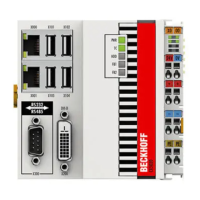General
TS505510 Version: 1.3
Parameterisable boundary conditions governing synchronisation
In principle, any initial conditions may apply to the calculation of the synchronisation profile for the master
and slave axes.
The transition of the slave's movement from its initial state to the synchronous state is calculated in such a
way that boundary conditions [}18] that can be specified by the user and that govern the slave's
movement are maintained. These boundary conditions can be used, for instance, to limit the maximum slave
velocity, or to prevent an overshoot in its position.
The calculation and checking of the parameterisable boundary conditions proceeds on the basis of the
characteristic values determined for the synchronisation phase. In the determination of the characteristic
values, the idealised assumption is made that the master axis will continue to move at a constant velocity,
i.e. with no acceleration, after the coupling time. Exact calculation and checking of the parameterisable
boundary conditions is only possible if this assumption is made. Any other reasonable assumption about the
future movement of the master is not possible, since the master's future movement is not known at the time
of coupling.
An acceleration of the master that might occur in the future will also affect the slave dynamics as a result of
the coupling. Such acceleration by the master will have the effect that the calculated and checked values
may be overshot or undershot in some cases, depending on the master's acceleration. Characteristic values
that may be affected by master acceleration can be seen in the tabular description of the characteristic values
[}21].
Characteristic values describing slave movement
The characteristic values [}21] governing the movement that the slave will undergo during the
synchronisation phase are available to the user after the Universal Flying Saw has been started. This value
structure contains magnitudes such as the maximum slave acceleration, the minimum and maximum slave
position, and so forth. These values are calculated under the assumption that the master is free from
acceleration, and are therefore in some cases only exactly correct for such a case.
NOTE
The master acceleration at the time that the "Universal Flying Saw" starts has a significant effect on the
profile calculation and its optimization. This means that if an encoder axis is the master, the velocity and the
acceleration must be carefully filtered, or even the calculation of the actual acceleration must be deselected
(see. "Encoder mode").

